NCERT Solutions Class 10 Social Science Chapter 2 Federalism have been provided below and is also available in Pdf for free download. The NCERT solutions for Class 10 Social Science have been prepared as per the latest syllabus, NCERT books and examination pattern suggested in Class 10 by CBSE, NCERT and KVS. Questions given in NCERT book for Class 10 Social Science are an important part of exams for Class 10 Social Science and if answered properly can help you to get higher marks. Refer to more Chapter-wise answers for NCERT Class 10 Social Science and also download more latest study material for all subjects. Chapter 2 Federalism is an important topic in Class 10, please refer to answers provided below to help you score better in exams
Chapter 2 Federalism Class 10 Social Science NCERT Solutions
Class 10 Social Science students should refer to the following NCERT questions with answers for Chapter 2 Federalism in Class 10. These NCERT Solutions with answers for Class 10 Social Science will come in exams and help you to score good marks
Chapter 2 Federalism NCERT Solutions Class 10 Social Science
NCERT Solutions for Class 10 Social Science Civics for Chapter 2 Federalism
Points to remember:
• In the previous chapter through the examples of Belgium and Srilanka we have studied about power sharing. There we saw that through the constitutional amendment of 1993 Belgium shared the power with different ethnic groups and solved the problem of conflicts on the other hand Sri Lanka acted opposite and the result was civil war.
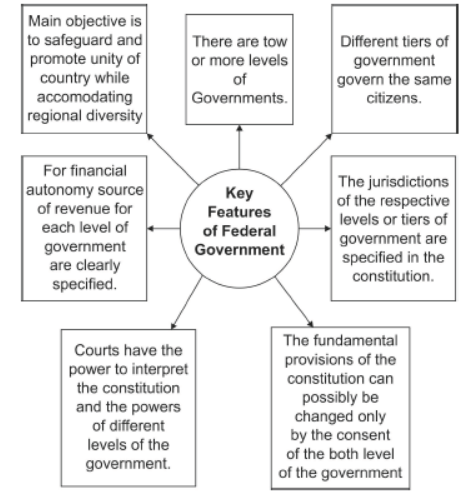
• Federalism is a system of government in which the power is divided between two or more levels. One is the government for the entire country that is usually responsible for a few subjects of common national interest. The others are government at the level of provinces or state that look after much of the day- to- day administration of their state. Both these levels of government enjoy their power independent of each other.
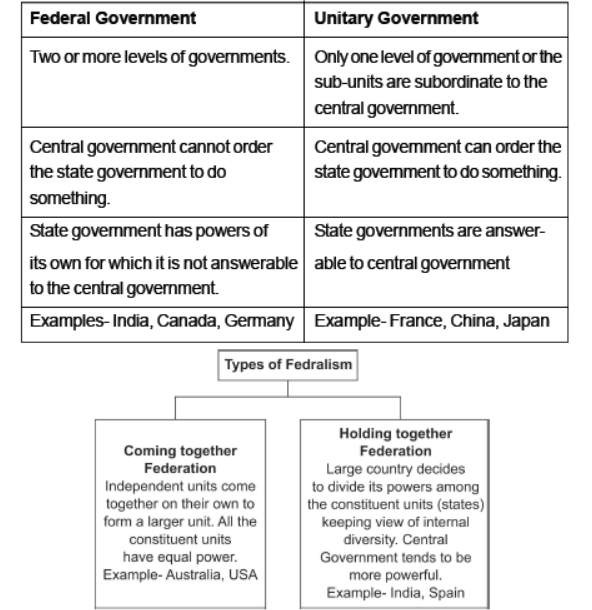
• India emerged as an independent nation after a painful and bloody partition. Soon after Independence several princely states became the part the country. The constitution clearly provided a threefold distribution of legislative powers between the Union government and state government. These are-
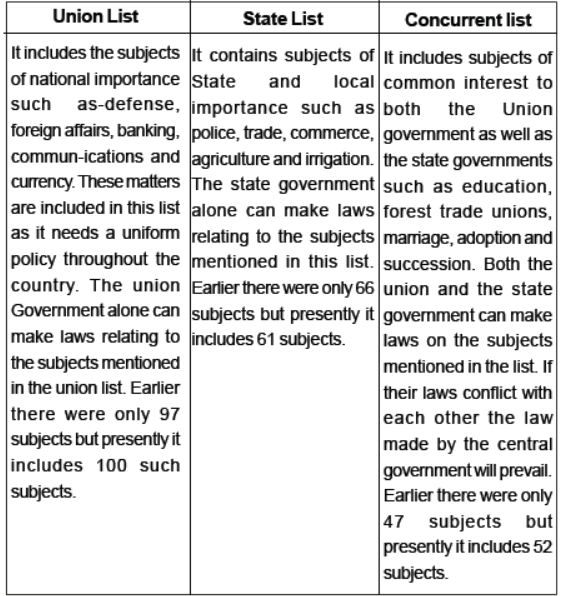
• What about subjects that do not fall in any of the three lists? Or subjects like computer software that came up after the constitution was made? According to our constitution the union government has the power to legislate on these ‘Residuary subjects’.
• The sharing of power between the Union government and the state government is basic to the structure of the constitution. It is not easy to make changes to this power sharing arrangement. The parliament cannot on its own change this arrangement. Any change to it has to be first passed by both the Houses of the Parliament with at least two- thirds majority. Then it has to be rectified by the legislatures of at least half of the total states.
• In case of any dispute about the division of powers, the High Courts and the Supreme courts make a decision. The Union and state governments have the power to raise resources by levying taxes in order to carry on the government and the responsibilities assigned to each of them.
Linguistic States
• The creation of Linguistic states was the first and a major test for democratic politics in our country.
• Boundaries of many previous states were changed in order to create new states.
• When the demand for the formation of states on the basis of language was raised, some national leaders feared that it would lead to the disintegration of the country.
• The central government resisted linguistic States for sometime but the experience has shown that the formation of linguistic states has actually made the country more united.
• It has also made administration easier.
• Some states were created not on the basis of language but to recognize difference based on the culture, ethnicity or geography.
Language Policy
• A second test for Indian federation is the language policy.
• Our constitution did not give the status of national language to any one language. Hindi was identified as the official language. But Hindi is the mother tongue of only about 40 % of Indian therefore there were many safeguard to protect other languages.
• Besides Hindi, there are 21 other languages recognized as Scheduled
Language by the constitution.
• A candidate in an examination conducted for the central government positions may opt to take the examination in any of these languages.
• States too have their own official languages. Much of the government work takes place in the official language of the concerned states.
• According to the Constitution the use of English for official purposes was to stop in 1965 but many non-Hindi speaking states demanded that the use of English continue.
• In Tamilnadu this movement took a violent form. The Central Government responded by agreeing to continue the use of English along with Hindi.
• Many critics think that this solution favoured the English- speaking elite.
• Promotion of Hindi continues to be the official policy the Government of India. Promotion does not mean that the central Government can impose Hindi on States where people speak a different language.
• The flexibility shown by the Indian political leaders helped our country avoid the kind of situation that Sri Lanka finds itself in.
Centre- State relation
• How the constitutional arrangements for sharing power works in reality depends to a large extent on how the ruling parties and leaders follow these arrangements.
• For a long time the same party ruled both at the centre and in most of the states. This meant that the State Governments did not exercise their rights as autonomous federal units.
• As and when the ruling party at the State level was different, the parties that ruled at the Centre tried to undermine the power of the States.In those days, the central Government would often misuse the Constitution to dismiss the state governments that were controlled by the rival parties.
• This undermined the spirit of federalism. All this changed significantly after 1990. This period saw the rise of regional political parties in many States of the country. This was also the beginning of the era of Coalition Governments at the centre.
• Since no single party got clear majority in the Lok Sabha, the major national parties had to enter into an alliance with many parties including several regional parties to form a government at the centre.
• This led to a new culture of power sharing and respect for the autonomy of State Governments.
• This trend was supported by a major judgement of the Supreme Court that made it difficult for the Central Government to dismiss state governments in an arbitrary manner.
• Thus federal power sharing is more effective today than it was in the early years after the constitution came into force.
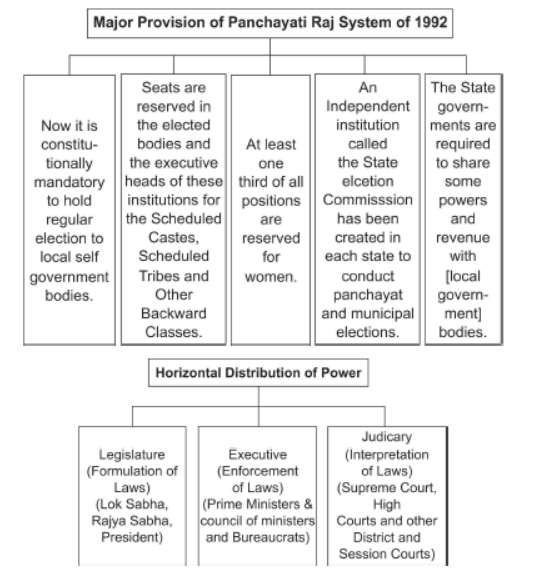
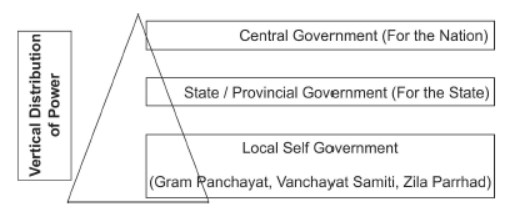
Gram Panchayat
• Rural local government is popularly known by the name of Panchayati Raj.
• Each village or a group of village in some states has a gram Panchayat.
• This is a council consisting of several ward members often called panch and a president or Sarpanch.
• They are directly elected by all the adult population living in that ward or village.
• It is the decision making body for the entire village. The Panchayat works under the overall supervision of gram Sabha. It has to meet at least twice or thrice in a year to approve the annual budget of the gram Panchayat and to review the performance of the gram Panchayat.
Panchayat Samiti
• The local government structure goes right up to the district level. A few gram panchayats are grouped together to form what is usually called a Panchayat samiti or block or mandal. The members of this representative body are elected by all the Panchayat members in that area.
Zila Parishad
• All the Panchayat samities or mandals in a district together constitute the zila parishad. Most members of the zila parishad are elected. Members of Lok Sabha and MLA of that district and some other officials of the other district level bodies are also its members. Zila parishad chairperson is the political head of the zila parishad. Municipalities/ Municipal corporations
• Similarly local government bodies exist for urban areas as well. Municipalities are set up in towns. Big cities are constituted into municipal corporations. Both Municipalities and municipal corporations are controlled by elected bodies consisting of people’s representatives. Municipal chair person is the political head of the municipality. In a municipal corporation such an officer is called the mayor.
NCERT Solutions for Class 10 Social Science Civics for Chapter 2 Federalism 1 Mark questions
Question. What is meant by decentralization of power?.
Answer. Giving powers to local government from centre and state Government.
Question. Which body plays an important role in the execution of constitutional provisions and practices?
Answer. The Supreme Court.
Question. According to our constitution which level of government can make laws on the residuary subjects?
Answer. Central Government
Question. Write the names of the local self government in the urban areas.
Answer. Municipalities and Municipal Corporations
Question. How Panchayat samiti is formed?
Answer. Grouping together of a few village Panchayat.
Question. Who is the head of Municipal Corporation?
Answer. Mayor
Question. Who is the political head of Zila Parishad?
Answer. Chairman
Question. Write the name of a nation which is an example of coming together federation?
Answer. USA
Question. Which level of government can make laws on the subjects of concurrent list?
Answer. Both centre and state government
Question. What is the need of local self government?
Answer. To rule over a large country.
Question. What is Zila Parishad?
Answer. Coming together of all the Panchayat samities of that district
Question.Rewrite the sentence after correcting the underlined word-Executive has the power to make laws.
Answer. Legislative
Question. Fill in the blanks-
Apart from Hindi(numbers) languages are scheduled in our constitution.
Answer. 21
Question. Which of the following is not an example of coming together federation.
(a) USA
(b) Switzerland
(c) Australia
(d) Spain
Answer. Spain
Question. An assertion (A) and its reason (R)is given below. Read the following statements and choose the right answer from the options given below.
Assertion (A): The distrust between Tamil and Sinhala resulted in the large scale confrontation.
Reasoning (R): A new constitution stipulated that the state shall protect and foster Buddhism.
(a) Both A and R are correct and R is the correct explanation of A
(b) Both A and R are correct but R is the not the correct explanation of A
(c) A is correct but R is incorrect
(d) A is incorrect but R is correct
Answer. A
Question. An assertion (A) and its reason (R)is given below. Read the following statements and choose the right answer from the options given below.
Assertion (A): India has a federal system.
Reasoning (R): There are three levels of government.
(a) Both A and R are correct and R is the correct explanation of A
(b) Both A and R are correct but R is not the correct explanation of A
(c) A is correct but R is incorrect
(d) A is incorrect but R is correct
Answer. A
Question. Explain the cartoon in your own words:
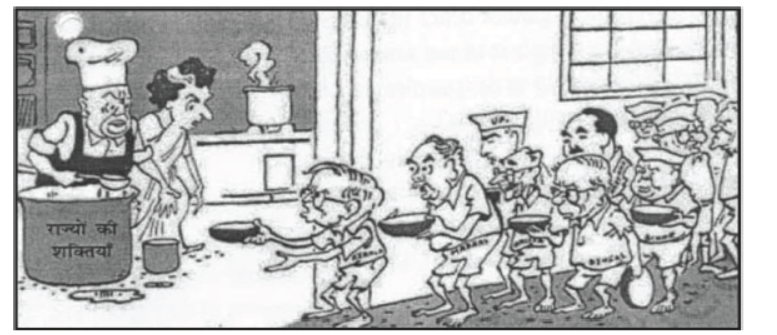
Answer. Student will write their own view
NCERT Solutions for Class 10 Social Science Civics for Chapter 2 Federalism Source Based Questions
Read the extract and answer the following questions-
Federalism is a system of government in which the power is divided between a central authority and various constituent units of the country. Usually, a federation has two levels of government. One is the government for the entire country that is usually responsible for a few subjects of common national interest. The others are governments at the level of provinces or states that look after much of the day-to-day administering of their state. Both these levels of governments enjoy their power independent of the other. In this sense, federations are contrasted with unitary governments. Under the unitary system, either there is only one level of government or the sub-units are subordinate to the central government. The central government can pass on orders to the provincial or the local government. But in a federal system, the central government cannot order the state government to do something. State government has powers of its own for which it is not answerable to the central government. Both these governments are separately answerable to the people.
Question. Which type of administration is present in India?
(a) Federal
(b) Unitary
(c) Despotic
(d) None of these
Answer. A
Question. What do you understand by the unitary form of government?
Answer. One level of government while other sub-units works under it.
Question. In which of the following country there is unitary form of government?
(a) India
(b) Sri Lanka
(c) Belgium
(d) USA
Answer. B
Question. Write a short description of the above paragraph.
Answer. After reading the extract student will solve themselves.
Read the source given below and answer the questions that follow:
Unlike Sri Lanka, the leaders of our country adopted a very cautious attitude in spreading the use of Hindi. According to the Constitution, the use of English for official purposes was to stop in 1965. However, many non Hindi speaking States demanded that the use of English continue. In Tamil Nadu, this movement took a violent form. The Central Government responded by agreeing to continue the use of English along with Hindi for official purposes. Many critics think that this solution favoured the English speaking elite. Promotion of Hindi continues to be the official policy of the Government of India. Promotion does not mean that the Central Government can impose Hindi on States where people speak a different language. The flexibility shown by Indian political leaders helped our country avoid the kind of situation that Sri Lanka finds itself in.
Question. When was the use of English stopped for official purpose in India?
Answer. In 1965
Question. Which other language was continued along with English for official purpose?
Answer. Hindi
Question. Which state demanded the use of English to continue?
Answer. Tamil Nadu
Question. Locate the following States on a blank outline political map of India:
Manipur, Sikkim, chhattisgarh and Goa.
Answer.
Question. Identify and shade three federal countries (other than India) on a blank outline political map of the world.
Answer
Question. Point out one feature in the practice of federalism in India that is similar to and one feature that is different from that of Belgium.
Answer. Both India and Belgium are federal republics. Both the countries have Central and State governments. The states enjoy autonomy in both the countries.
In Belgium, the state government is not subordinate to the Centre. But in India the Centre has more powers. The Centre can even dismiss the state government. However, the Supreme Court of India has now made it difficult for the Centre to dismiss a state government in an arbitrary manner.
Question. What is the main difference between a federal form of government and a unitary one? Explain with an example.
Answer.
- In a unitary government, the national government has all the powers whereas federalism is a system of government in which the power is divided between a central authority and various constituent units of the country.
- India has a central government to rule the country as well as state governments at the regional level. Therefore, India is a federal republic.
- In Sri Lanka, the national government has all the powers. Therefore, Sri Lanka is an example of unitary form of government.
Question. State any two differences between the local government before and after the Constitutional amendment in 1992.
Answer.
Prior to the Constitutional amendment of 1992 –
- Elections to the local bodies were not held regularly.
- The local governments did not have any powers or resources of their own.
After the amendment of 1992 –
- It became constitutionally mandatory to hold regular elections to local government bodies.
- State governments are required to share revenue and some powers with the local government bodies.
Question. Fill in the blanks:
Since the United States is a type of federation, all the constituent States have equal powers and States are _vis-à-vis the federal government. But India is a type of federation and some States have more power than others. In India, the government has more powers.
Answer.
Since the United States is a coming together type of federation, all the constituent States have equal powers and States are strong vis-à-vis the federal government. But India is a holding together type of federation and some States have more power than others. In India, the Central government has more powers.
Question. Here are three reactions to the language policy followed in India. Give an argument and an example to support any of these positions.
Sangeeta: The policy of accommodation has strengthened national unity.
Arman: Language-based States have divided us by making everyone conscious of their language.
Harish: This policy has only helped to consolidate the dominance of
English over all other languages.
Answer. I agree with Sangeeta’s statement. The policy of accommodation has actually strengthened national unity.
- Initially, the demand for formation of states on the basis of language was resisted by our leaders. It was feared that it would lead to disintegration. On the contrary, it made the country more united and also helped in administration.
- The Indian Constitution did not give the status of national language to any one language. However, Hindi was made the official language.
- Apart from Hindi, 21 other languages were declared as Scheduled Languages. There were safeguards to protect these languages. A person may take up an examination for central government positions in any of these languages.
- The states too have their own official languages.
- Thus, India’s language policy allowed it to avoid a Sri Lanka kind of a situation.
Question. The distinguishing feature of a federal government is:
a) National government gives some powers to the provincial governments.
b) Power is distributed among the legislature, executive and judiciary.
c) Elected officials exercise supreme power in the government.
d) Governmental power is divided between different levels of government.
Answer:
(d) Governmental power is divided between different levels of government.
Question. A few subjects in various lists of the Indian Constitution are given here. Group them under the Union, State and Concurrent Lists as provided in the table below:
A. Defence
B. Police
C. Agriculture D. Education E. Banking
F. Forests
G. Communications
H. Trade
I. Marriages
|
Union List |
|
|
State List |
|
|
Concurrent list |
|
Answer:
|
Union List |
A. Defence; E. Banking; G. Communications |
|
State List |
B. Police; C. Agriculture; H. Trade |
|
Concurrent List |
D. Education; F. Forests; I. Marriages |
Question. Examine the following pairs that give the level of government in India and the powers of the government at that level to make laws on the subjects mentioned against each. Which of the following pairs is not correctly matched?
|
(a)State Government |
State List |
|
(b) Central Government |
Union List |
|
(c) Central and State Governments |
Concurrent List |
|
(d) Local Government |
Residuary powers |
Answer: (d) Local Government Residuary powers
Question. Match List I with List II and select the correct answer using the codes given below the lists:
|
List I |
List II |
|
1. Union of India |
A. Prime Minister |
|
2. State |
B. Sarpanch |
|
3. Municipal Corporation |
C. Governor |
|
4. Gram Panchayat |
D. Mayor |
|
|
1 |
2 |
3 |
4 |
|
(a) |
D |
A |
B |
C |
|
(b) |
B |
C |
D |
A |
|
(c) |
A |
C |
D |
B |
|
(d) |
C |
D |
A |
B |
Answer. – (c)
Question. Consider the following two statements.
A. In a federation the powers of the federal and provincial governments are clearly demarcated.
B. India is a federation because the powers of the Union and State Governments are specified in the Constitution and they have exclusive jurisdiction on their respective subjects.
C. Sri Lanka is a federation because the country is divided into provinces.
D. India is no longer a federation because some powers of the States have been devolved to the local government bodies.
Which of the statements given above are correct?
|
(a)A, B and C |
(b)A, C and D |
(c)A and B only |
(d)B and C only |
Answer.(c) A and B only
NCERT Solutions for Class 10 Social Science Civics for Chapter 2 Federalism Very Short Answer Questions
Question. How are members of Panchayat Samiti elected?
Answer. The members of Panchayat Samiti are elected by all Panchayat members in that area.
Question. What is a Zila Parishad?
Answer. All the Panchayat Samitis or mandals in a district together constitute the Zila Parishad.
Question. What is ‘Unitary System’?
Answer. Either there is only one level of government or the sub units are subordinate to the Central government.
Question. What is Federal system of Government?
Answer. In a Federal system, the Central Government cannot order the state government to do something. State Government has powers of its own for which it is not answerable to the Central Government.
Question. What does ‘Jurisdiction’ mean?
Answer. The area over which government has legal authority, whether geographical boundaries or certain kinds of subjects.
Question. How is financial autonomy of each tier of government ensured?
Answer. Sources of revenue for each level of government are clearly specified in the Constitution.
Question. What are the dual objectives of a federal system?
Answer. To safeguard and promote unity of the country and at the same time accommodate regional diversity.
Question. What is ‘coming together federation’?
Answer. When independent states come together on their own, form a bigger unit, so that by pooling sovereignty and retaining identity, they can increase their security.
Question. Explain the term ‘holding together federation’?
Answer. When a country decides to divide its power between the constituent states and the national government.
Question. What are Municipalities and Municipal Corporations?
Answer. These are the bodies in smaller towns and Municipal Corporations are meant for bigger towns.
Question. Who are the chairpersons of Municipalities and Municipal Corporations?
Answer. Municipal chairman and Mayor.
Question. What form of government was existing in Sri Lanka?
Answer. A unitary system, where the national government has all the powers.
Question. What is ‘Federalism’?
Answer. A system of government in which the power is divided between a central authority and various constituent units of the country.
Question. Who has power to make law?
Answer. Legislature or Parliament makes Laws.
Question. Name the Union Territories of India.
Answer. Chandigarh, Lakshadweep Islands, Andaman and Nicobar Islands, Dadar and Nagar Haveli and Daman and Diu, Puducherry, Capital city of Delhi, Ladakh and Jammu and Kashmir.
Question. Is it easy to make changes in the power sharing arrangement of India? Explain.
Answer. No, the Parliament cannot on its own change this arrangement.
Question. How are changes made in power sharing arrangement of a country?
Answer. Any change to it has to be first passed by both the Houses of Parliament with atleast two-thirds majority. Then it has to be ratified by the legislatures of at least half of the total states.
Question. What is the role of judiciary in power sharing arrangement?
Answer. Overseeing the implementation of constitutional provisions and procedures.
NCERT Solutions for Class 10 Social Science Civics for Chapter 2 Federalism Short Answer Questions
Question. How is Panchayat Samiti formed and at what level?
Answer. (i) Panchayat Samiti is formed at the block level.
(ii) The members of this representative body are elected by all the Panchayat members in that area.
(iii) A few Gram Panchayats are grouped together to form a Panchayat Samiti or Block or Mandal.
Question. What is Panchayati Raj?
Answer. (i) Rural local government is popularly known by the name of Panchayati Raj.
(ii) It has been divided into three tiers or three levels.
(iii) At the village level, there is a Gram Panchayat; at the block level, there is a Block Committee and at the district level, there is a Zila Parishad.
Question. What are the two levels of federalism?
Answer. Federalism has two levels of government:
(i) One is the government for the entire country that is usually responsible for a few subjects of common national interest.
(ii) The others are governments at the level of provinces or states that look after much of the day-to-day administering of their state.
Question. What difficulties are faced during local government elections?
Answer. (i) While elections are held regularly and enthusiastically, Gram Sabhas are not held regularly.
(ii) Most State governments have not transferred significant powers to the local governments.
(iii) Nor were they given adequate resources.
NCERT Solutions for Class 10 Social Science Civics for Chapter 2 Federalism Long Answer Questions
Question. Describe the three-fold distribution of legislative powers between the Union government and State government.
OR
How is sharing of power between the union and the State governments basic to the structure of the constitution of India? Explain.
Answer. It contains three lists:
(i) Union List: It includes subjects of national importance such as defence of the country, foreign affairs, banking, communications and currency. They are included in this list because we need a uniform policy on these matters throughout the country.
(ii) State List: The list contains subjects of state and local importance such as police, trade, commerce, agriculture and irrigation. The state governments alone can make laws relating to the subjects mentioned in the state list.
(iii) Concurrent List: Includes subjects of common interest to both, the Union government as well as the State government such as education, forests, trade unions, marriage, adoption and succession. Both the Union as well as State governments can make laws on the subjects mentioned in this list. If their laws conflict with each other, the law made by the Union government prevails.
Question. How is a Zila Parishad formed?
Answer. (i) All the Panchayat Samitis or mandals in a district together constitute the Zila Parishad.
(ii) Most members of the Zila Parishad are elected.
(iii) Members of the Lok Sabha and MLAs of that district and some of the officials of other district level bodies are also its members.
(iv) Zila Parishad chairperson is the political head of the Zila Parishad.
Question. How is power shared in a coalition government?
Answer. After 1990, there was the rise of regional political parties as well as the beginning of the era of ‘Coalition Governments’ at the Centre. Since no single party got a clear majority in the Lok Sabha, the major national parties had to enter into an alliance with many parties including several regional parties to form a government at the centre. This led to a new culture of power sharing and respect for the autonomy of State governments. This trend was supported by a major judgement of the Supreme Court that made it difficult for the Central Government to dismiss state governments in an arbitrary manner.
Thus federal power sharing is more effective today than it was in the early years after the Constitution came into force.
Question. Distinguish between ‘coming together federation’ and ‘holding together federations’ with examples. India comes under which type of federation?
Answer. Coming Together Federation:
It involves independent states coming together on their own to form a bigger unit, so that by pooling sovereignty and retaining identity, they can increase their security.
E.g.: USA, Australia
In this category of federation, all the constituent states usually have equal powers and are strong as a federal government.
Holding Together Federations:
Here, a large country decides to divide its power between the constituent states and the national government. In this kind of federalism, Central government tends to be more powerful than the states. Very often different constituent units of federation have unequal powers. Some units are granted special powers.
For e.g. India, Spain, Belgium, etc.
Question. Which five provisions of the Indian constitution make India a full fledged federation? Explain.
Answer.
- There are two or more levels of government.
- Different tiers of government govern the same citizens, but each tier has its own jurisdiction.
- The jurisdiction of the respective levels or tiers of government are specified in the constitution.
- The fundamental provisions of the constitution cannot be unilaterally changed by one level of the government.
- Sources of revenue for each level of government are clearly specified to ensure its financial autonomy.
- Courts have the power to interpret the constitution and the powers of different levels of government.
So, an ideal federal system has both aspects—mutual trust and agreement to live together.
Question. What is the rational decentralisation of power? Describe the functions of rural local government.
Answer.
- The basic idea behind decentralisation is that, there are a large number of problems and issues which are best settled at the local level.
- People have better knowledge of problems in their localities.
- They also have better ideas on where to spend the money and how to manage things more efficiently.
- At the local level, it is possible for the people to directly participate in decision-making.
This helps to inculcate a habit of democratic participation.
Functions of Rural Government:
- The local government is a three-tier structure. At the top is the District or Zila Parishad,few blocks form a Zila, so blocks have Block or Mandal and then few villages form a block and a village panchayat.
- The smallest unit of our country is a village and at the village level, we have Gram Panchayat, which is run by a head called ‘Sarpanch’ with his team of representatives.
- A few Gram Panchayats fall under a Block. At Block level, we have a Panchayat Samiti or Block Committee.
- All Panchayat Samitis of a district are under a district having a local government called Zila Parishad. Members of Lok Sabha and MLAs of that district also become the members of Zila Parishad.
Question. How challenge of language policy was adopted by the Indian federalism?
Answer.
- A second test for Indian federalism is the language policy.
- Our Constitution did not give the status of national language to any one language.
- Hindi was identified as the official language.
- But Hindi is the mother tongue of only about 40 per cent of IndiAnswer. Therefore, there were many safeguards to protect other languages.
- Besides Hindi, there are 21 other languages recognised as Scheduled Languages by the Constitution.
- A candidate in an examination conducted for the Central Government positions may opt to take the examination in any one of these languages.
- States too have their own official languages. Much of the government work takes place in the official language of the concerned state.
| NCERT Solutions Class 10 Social Science Chapter 1 Resources and development |
| NCERT Solutions Class 10 Social Science Chapter 2 Forest and Wildlife Resources |
| NCERT Solutions Class 10 Social Science Chapter 3 Water Resources |
| NCERT Solutions Class 10 Social Science Chapter 4 Agriculture |
| NCERT Solutions Class 10 Social Science Chapter 5 Minerals and Energy Resources |
| NCERT Solutions Class 10 Social Science Chapter 6 Manufacturing Industries |
| NCERT Solutions Class 10 Social Science Chapter 7 Lifelines of the National Economy |
| NCERT Solutions Class 10 Social Science Chapter 1 Power Sharing |
| NCERT Solutions Class 10 Social Science Chapter 2 Federalism |
| NCERT Solutions Class 10 Social Science Chapter 3 Democracy and Diversity |
| NCERT Solutions Class 10 Social Science Chapter 4 Gender Religion and Caste |
| NCERT Solutions Class 10 Social Science Chapter 5 Popular Struggles and Movements |
| NCERT Solutions Class 10 Social Science Chapter 6 Political Parties |
| NCERT Solutions Class 10 Social Science Chapter 7 Outcomes of Democracy |
| NCERT Solutions Class 10 Social Science Chapter 8 Challenges to Democracy |
| NCERT Solutions Class 10 Social Science Chapter 1 The Rise of Nationalism in Europe |
| NCERT Solutions Class 10 Social Science Chapter 2 Nationalism in India |
| NCERT Solutions Class 10 Social Science Chapter 3 The Making of a Global World |
| NCERT Solutions Class 10 Social Science Chapter 4 The Age of Industrialization |
| NCERT Solutions Class 10 Social Science Chapter 5 Print Culture and Modern World |
| NCERT Solutions Class 10 Economics Chapter 1 Development |
| NCERT Solutions Class 10 Economics Chapter 2 Sectors Of The Indian Economy |
| NCERT Solutions Class 10 Economics Chapter 3 Money And Credit |
| NCERT Solutions Class 10 Economics Chapter 4 Globalization And The Indian Economy |
| NCERT Solutions Class 10 Economics Chapter 5 Consumer Rights |
NCERT Solutions Class 10 Social Science Chapter 2 Federalism
The above provided NCERT Solutions Class 10 Social Science Chapter 2 Federalism is available on our website for free download in Pdf. You can read the solutions to all questions given in your Class 10 Social Science textbook online or you can easily download them in pdf. The answers to each question in Chapter 2 Federalism of Social Science Class 10 has been designed based on the latest syllabus released for the current year. We have also provided detailed explanations for all difficult topics in Chapter 2 Federalism Class 10 chapter of Social Science so that it can be easier for students to understand all answers. These solutions of Chapter 2 Federalism NCERT Questions given in your textbook for Class 10 Social Science have been designed to help students understand the difficult topics of Social Science in an easy manner. These will also help to build a strong foundation in the Social Science. There is a combination of theoretical and practical questions relating to all chapters in Social Science to check the overall learning of the students of Class 10.
You can download the NCERT Solutions for Class 10 Social Science Chapter 2 Federalism for latest session from StudiesToday.com
Yes, the NCERT Solutions issued for Class 10 Social Science Chapter 2 Federalism have been made available here for latest academic session
Regular revision of NCERT Solutions given on studiestoday for Class 10 subject Social Science Chapter 2 Federalism can help you to score better marks in exams
Yes, studiestoday.com provides all latest NCERT Chapter 2 Federalism Class 10 Social Science solutions based on the latest books for the current academic session
Yes, NCERT solutions for Class 10 Chapter 2 Federalism Social Science are available in multiple languages, including English, Hindi
All questions given in the end of the chapter Chapter 2 Federalism have been answered by our teachers

